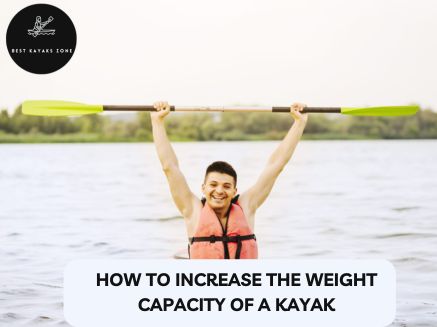Kayaking is a really enjoyable pastime that we all want to do. Kayaks are necessary for kayaking, but since everyone has different preferences and it isn’t always possible to obtain the kayak of our choice, we often modify existing kayaks to suit our needs.
One alteration we can make is to make a kayak heavier. All the required procedures you can take to raise the weight of your kayak will be covered in this post.

Methods to Increase the weight capacity of a Kayak
There are various techniques by which you can increase your kayak weight capacity let’s plot them down one by one.
1. Use styrofoam blocks to pack your kayak
The best packing material for your kayak is foam blocks. They are manageable because they are lightweight. When you utilize them, nothing will be harmed. Hardware retailers sell these blocks.
Finding the ideal one for you is easy because they are available in a variety of sizes and shapes. Cut the blocks to the size of your kayak to make packing simpler. This is a quick and easy way to increase the amount of weight your kayak can carry.
2. Add more waterproofing materials
Rubber bands, plastic bags, and duct tape are all necessary waterproofing supplies if you intend to use your kayak for fishing. If you need to temporarily secure anything, duct tape works wonderfully. Rubber bands come in extremely handy for securing objects. Plastic bags are a more practical and portable alternative to plastic containers for storing food and equipment.
Your clothing may become wet when kayaking, adding to the weight. Waterproofing then becomes important. Try to waterproof your bags and other essentials as much as you can because doing so will keep them dry and make them lighter.
3. Remove the floorboards
To increase the weight capacity of your kayak, remove the floorboards. You can do this by removing the screws holding the boards down. Once you have removed the boards, you can easily lift the bottom of the kayak out.
Now that you’re able to access the bottom of the kayak, you can add additional styrofoam blocks or other heavy objects. If you want to be extra careful, you can cover the bottom of the kayak with waterproofing material before adding any heavy items.
4. Use kayak floatable bags
The weight capacity of your kayak is increased with floatable bags, which also protect you from capsizing. Buoyancy bags, as opposed to inflatable bags, connect to the sides of the kayak rather than taking up interior space. This eliminates the risk of the kayak tipping when you pack it full of extra gear.
However, you shouldn’t pack your buoyancy bags until after the rest of your equipment. Never overfill buoyancy bags because doing so could cause the kayak to capsize. Kayak buoyancy bags not only boost weight capacity but also stability. While they might be pricey and take up valuable kayak space, they will increase the weight capacity of your kayak and let you carry more gear.
5. Use a kayak stabilizer system
Stabilizers are a wonderful technique to boost your kayak’s weight capability. They could be fixed to your kayak or inflatable. When not in use, inflatable ones are simple to deflate and install. There are also retractable stabilizers available. They can give you extra stability when you’re fishing and can assist you in rapidly regaining your balance in choppy water.
Additionally, they can help you stay safe while paddling in choppy water by reducing excessive movement. Additionally, they can lessen your likelihood of being seasick. But you ought to pick a kayak with the right weight capacity.
6. Use pool noodles for flotation
Make sure you understand the impact pool noodles will have on your kayak’s weight capacity if you’re thinking about doing so.
These noodles will enhance buoyancy to a SOT hull, but they will only do so if a sizable amount of water is displaced. This indicates that the hatches must be opened and that a wave is approaching from above.
In these conditions, the additional air volume will offer greater buoyancy than the additional weight of the pool noodles. Pool noodles can increase the weight capacity of your kayak and also increase its stability. They are reasonably priced and simple to locate at your neighbourhood pool supply store.
When buying them, split them in half and tie the front and back together. The pool noodles can be fastened to the kayak with zip ties or duct tape. Once fastened, use a pump to blow them up.
Pool noodles likely won’t survive in salt water because they don’t float as well as commercial stabilizers. To ensure that you stay afloat and remain safe, stabilizers are a worthwhile investment if you intend to kayak in saltwater.
Your kayak’s weight capacity can be increased by adding a few pounds to the bottom in the form of inflatable pool noodles. Any pool supply business will sell pool noodles. It can be taped or zip-tied to the bulkhead of the kayak. These inflatable flotation devices are not only affordable but also a terrific way to add weight.
7. Techniques of paddling
When your kayak is loaded near to or above its maximum weight capacity, practising proper paddling tactics can also be helpful. The amount of water that enters the cockpit of your kayak will be reduced with good paddling technique. Additionally, it will enable you to enhance the efficiency of your paddle strokes, preventing fatigue from setting in as soon.
If you’re headed out in a kayak that you already know is heavy, it’s never a bad idea to minimize tiredness. That way, when the day is done, you’ll have the strength to carry that large, hefty kayak back to shore.
8. Modify the kayak design
You can think about altering your kayak’s structure if you want to increase the maximum weight it can support. The crucial area to concentrate on when accomplishing this is the kayak’s hull.
The hull design of a kayak symbolizes the function for which it is intended. Pontoon hulls, sometimes known as “tunnel” hulls, are some of the best kayaks for fishing since they are the most stable while your kayak is stationary or when you’re standing to catch fish.
A less complicated alteration is to insert airbags inside one (or more) of your kayak’s hull chambers. This may give your kayak additional buoyancy, enabling it to carry heavier cargo on farther voyages.
9. Kayaking location
Changing where you paddle is one way to increase the weight your kayak can support. This strategy focuses more on preventing and reducing overloading than it does on increasing the weight of the kayak.
Even while your kayak might not be filled, stronger weather and higher waves will cause more water to splash into your cockpit. You will sink shockingly further into the water as the cockpit of your kayak fills, increasing the likelihood that you may have to dump the water out or leave your kayak entirely.
You can get away with adding more weight to your kayak if you routinely paddle on calm, level waters. Remember that salt water is naturally more buoyant than water as well.
You must consider the weight capacity when choosing a kayak to ensure that it can safely transport you. The weight capacity of the kayak cannot be significantly increased, but even if it were, it could still be utilized efficiently while being a few extra pounds heavier.
When you determine what size kayak you need and you simply need to make the right investments in equipment and develop the right configuration by knowing how to improve kayak weight capacity. We hope that we were able to address every component of a kayak’s weight rise. Keep visiting our website if you want to view more kayak-related material.
FAQS:
What happens when you exceed the weight capacity of a kayak?
As you navigate disorderly water in a kayak, we advise against overloading tendencies. Even though going over the Kayak weight limit won’t necessarily result in waterlogging, the boat will sink below the waterline. As a result, the stability as a whole will be severely impacted.
If you are a person who exceeded 400 pounds, then you should refer to the best kayak for 400lb capacity article to get one.
Where should the heaviest person sit on a kayak?
Generally speaking, you should paddle with the person who is heavier in the back of the kayak. When the boat is balanced. It is preferable to have the kayak’s bow somewhat upturned and its stern slightly sunk into the water.
You’ll have more speed and control as a result. The stern rudder may work more effectively if the heavier kayaker is at the back.
What is the best kayak for a heavy person?
The ideal kayak for a person with a larger build is typically a sit-on-top kayak featuring a wide beam and high weight capacity. It is advisable to opt for models explicitly designed for individuals with higher weight requirements.
How can one increase the weight capacity of a kayak?
Enhancing the weight capacity of a kayak is not a straightforward process. The weight capacity is primarily determined by the kayak’s design and construction. Attempting to modify an existing kayak to increase its weight capacity may compromise its safety and performance. It is recommended to invest in a kayak specifically engineered to handle higher weight capacities.
Is it possible to increase the weight capacity of a kayak?
In general, it is not recommended to increase the weight capacity of a kayak. The weight capacity is determined by various factors, including the materials, structure, and design of the kayak. Modifying a kayak to enhance its weight capacity can jeopardize its stability, integrity, and safety. It is advisable to select a kayak that already meets your desired weight capacity.



